If you were a kid in high school (or college) during the mid-late 1980s – and into fast cars – you probably have a place in your heart for the last full-frame, rear-drive/live axle, carbureted cast-iron V-8 muscle car GM ever made:
The ’83-’88 Monte Carlo SS.
It was conceived at a time when memories of the original muscle cars of the 1960s and ’70s still lingered and everyone was hoping maybe they’d make a comeback, somehow.
Ford was the first to take a stab at it with the ’82 Mustang GT. “The Boss is back,” read the ad copy. And it was kinda-sorta true. The car did have a reasonably rumbly 302 V8. But the econo-boxy body (and four-lug wheels) along with the two-barrel carb sitting on top of the trying-hard Ford small-block didn’t quite make it. GM’s Camaro/Firebird twins were ok, too. But they lacked the heavy-hitter presence of the old school stuff.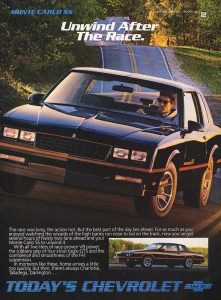
The SS Monte had presence in spades.
Its striking Winston Cup bodywork – shovel-nose front end with quad headlights, blacked-out grille, monochromatic paint job, beefy Eagle GT tires and rumpety-rump sewer pipe-sized dual exhaust hanging prominently behind the rear axle “pumpkin” – made it an instant hit in 1983, the first year of production.
Even better, the SS packed the goods to go with the stock car looks. Under that broad, flat hood sat the same basic “L69 HO” 305 cubic inch engine that became the optional engine in the Camaro Z-28 and Pontiac Trans-Am that year. The 5.0 V8 was old-time muscle – from its cast iron block and heads to its aluminum medium-riser intake manifold capped off with a Rochester Quadrajet 750 CFM 4-barrel carburetor.
To bump up the little 305’s output, Chevy fitted this engine with a higher-lift cam from the Corvette’s optional L82 350 V8, upped the compression to 9.5:1 and added a free-flow exhaust system with much-less-restrictive Corvette honeycomb (vs. pellet) catalytic converter and a lower-restriction air cleaner. 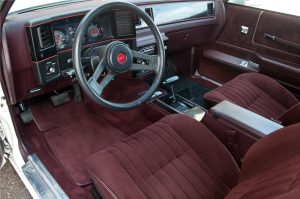
Though this exact same engine was rated at 190 hp in the Z-28, the Monte’s version was downrated slightly, to 180-hp. Probably to avoid annoying the Camaro faithful but also perhaps because the Monte’s version of the L69 305 got a single-snorkel air cleaner while those installed in the same-year got a dual snorkel.
Easily fixed.
By the standards of our time – almost 40 years down the road – 180 hp out of 5.0 liters doesn’t seem like very much. But in the early Reagan Years, it was more than just about anything else on the we road was packing.
Only the Corvette had bigger guns.
Performance? A stock Monte Carlo SS was good for mid-15 second quarter mile runs and 0-60 blasts under 8 seconds – hot runs for the era. But what made the car so much fun – so much like the big block muscle cars of the past – was the easy tire-frying burnouts (no traction control in those days), the tire-chirping 1-2 upshifts through the specially calibrated automatic transmission and the NASCAR rumble of a straight-up small block V8.
Flip the air cleaner lid to let the Q-Jet breathe deep, ax the catalytic converter – and you were ready to rumble.
More rumble was easy to install, too. The 305 was, after all, a small block Chevy V8 and all the traditional enhancements of the ’60s worked just as well in the ’80s. A hotter cam and some headers and you had ’60s performance in an ’80s muscle car, with much more comfortable seats and – if you wanted – T-tops.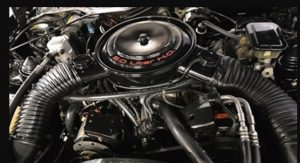
Which let you feel the breeze and hear the sounds.
First year sales were decent – but limited by available production capacity. Only 4,714 examples made it through the pipeline at a base MSRP of $10,474 (which was just slightly more expensive than the ’83 Camaro Z-28’s base price of $10,336).
1984 was much better – with sales increasing nearly six-fold to 24,050. This trend continued into 1985, with sales climbing steadily to a production capacity limited 35,484. Chevy could have sold even more Montes if the two plants where they were built in Arlington, Texas and Pontiac, Michigan had been able to bolt more of them together – but overall, the car’s performance on the lot was every bit as solid as its performance on the street.
In ’86, Chevy came out with a limited-edition version of the SS called the Aerocoupe – designed with NASCAR competition in mind, just like in the good old days of the Plymouth Superbird and Charger Daytona.
The Aerocoupe was defined by its unique raised rear glass, which followed the roofline back to the tail to cut aerodynamic drag at high speeds. According to published figures, the swept-back “aero” rear glass reduced the car’s drag coefficient relative to the standard notchback SS by nearly 3 percent – a big deal on the high-speed ovals where race versions of the Monte were running. These cars also had a unique ducktail spoiler which provided additional downforce on the car’s rear end – and added to the heavy-breathing stock car ambiance.
’86 was also the first year for standard gas-charged Delco Bilstein shocks and new argent/aluminum 15×7 wheels very similar to the ones first used on the ’80-81 Camaro Z-28.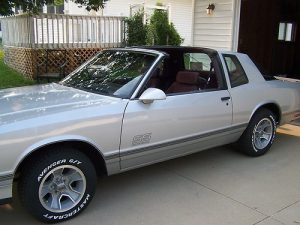
Of the 161,067 SS Monte Carlos produced during the five year run between 1983 and 1988, Aerocoupes are the most rare – 1986 models especially. Just 200 were produced – with another 6,052 built the following year. All were white – with identical options – which would have included the new-for-’86 15×7 aluminum rims with Goodyear Eagle GT tires, F41 sport suspension with high-effort steering and special “SS” decals and stripes.
Base price for the ’87 Aerocoupe was $14,838 vs. $13,463 for the standard notchback SS.
By this time, unfortunately, sales had begun to slide – down to 16,204. 1988 would be the final year for the Monte Carlo SS – and, sadly, for a rear-drive, V-8 Monte Carlo. Chevy decided the future lay in smaller, front-drive models like the soon-to-be-released Lumina.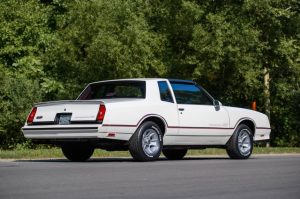
The Monte Carlo nameplate would be revived a few years later – and V8 power would return in 2006 (though in a front-drive configuration and with modern engine controls). But the classic muscle car layout of ’83-’88 was history – too crude for modern tastes; too politically incorrect to pass muster with Uncle
Every now and then, you’ll hear a memory. The sound of an old SS under full steam – Q-jet secondaries opening up, Eagle GT’s skittering on the pavement – a happy reminder of simpler times, of cheap thrills, of an America that was and maybe, one day, will be again.
They may build ’em faster – but they’ll never build ’em sweeter.
. . .
Got a question about cars, Libertarian politics – or anything else? Click on the “ask Eric” link and send ’em in!
If you like what you’ve found here please consider supporting EPautos.
We depend on you to keep the wheels turning!
Our donate button is here.
If you prefer not to use PayPal, our mailing address is:
EPautos
721 Hummingbird Lane SE
Copper Hill, VA 24079
PS: Get an EPautos magnet or sticker or coaster in return for a $20 or more one-time donation or a $10 or more monthly recurring donation. (Please be sure to tell us you want a magnet or sticker or coaster – and also, provide an address, so we know where to mail the thing!)
If you’d like an ear tag – custom made! – just ask and it will be delivered.
My latest eBook is also available for your favorite price – free! Click here. If that fails, email me at EPeters952@yahoo.com and I will send you a copy directly!


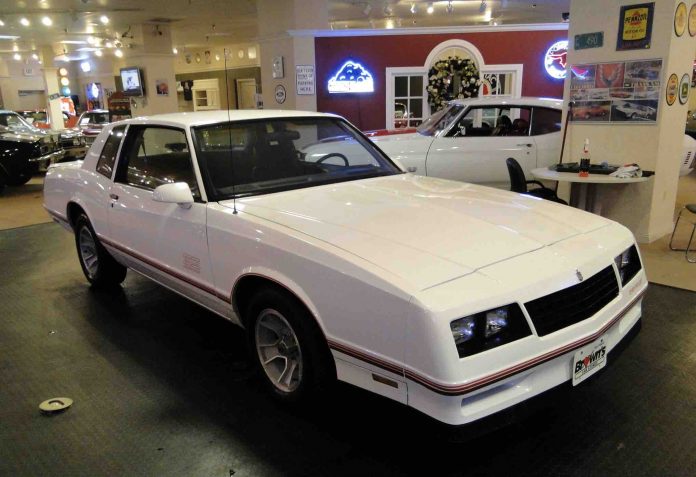









The g-body cars are a wonderful alternative to the pricier and earlier muscle cars. Not to mention a large aftermarket to support modifying or restoring these cars. The big modification now is an LS engine conversion. One of those in a 3400 lb car sure would be a lot of fun!
I’ve always liked the G body cars too. I used to own an 85 cutlass supreme, the old man (used car dealer) had multiples of G bodies. More notably an 82 Regal with a .060 over 396/12 bolt rear in it and a pro street 87 Cutlass tubbed/narrowed with a healthy sbc under the hood. I still kick myself for not buying the Regal when he sold it.
Eric – thanks for the memories! Had a maroon ‘88 – selling it is one of my top 5 car regrets. Loved that car. Bought it from a buddy of mine – he originally had a white ‘87 that he used to tow his ski boat. Totaled the ‘87 – insurance bought him the ‘88. I remember racing his ‘87 in my ‘86 Lincoln LSC. The old carbureted 305 gave my 302HO a run for its money!
The only thing I didn’t like about the Monte was the SS stripes. They looked so dated after a couple of years. Had to repaint the car to get rid of them. Sure looked great once that was done. Would love to have it back.
Eric – thanks for the memories! Had a maroon ‘88 – selling it is one of my top 5 car regrets. Loved that car. Bought it from a buddy of mine – he originally had a white ‘87 that he used to tow his ski boat. Totaled the ‘87 – insurance bought him the ‘88. I remember racing his ‘87 in my ‘86 Lincoln LSC. The old carbureted 305 gave my 302HO a run for its money!
The only thing I didn’t like about the Monte was the SS stripes. They looked so dated after a couple of years. Had to repaint the car to get rid of them. Sure looked great once that was done. Would love to have it back.
My parents bought an 83 Monte SS new. The old man promptly removed the catalytic converter(s) and ‘tweaked’ the tune a bit. My skinny (160 pound) stepbrother got it to run a 14.9x in the 1/4 mile.
I was never a fan of the 305 chevy but 14.9 was respectable in 1983.
Ever heard of the Mexican Monte SS? 350 and a 4 speed from the factory.
http://www.montecarloss.com/MexicanSS.html
Hey! Thanx for that link – learn something new every day!
Loved SS Montes when they came out, like em still. Would definitely be on my list of cars to own someday, were the economy and the country not ending. Had a couple of friends that bought them new bitd – guess my experiences then will hafta suffice.
Always loved the Carlo SS but let’s be honest – the 305 was a piece of crap.
Undersquare, badly-flowing heads, limp cam, no ability to rev.
I’ve never figured out why GM didn’t just adapt the 350 for the G-body – doing that couldn’t possible have been more expensive than coming up with a new engine.
Hi Ice Age,
The 305 should be put into context. Yes, by current standards, it was weak and limited. But circa 1985, the L69 305 was one of the hottest engines available and the cars it was installed in (Monte SS, Z28 Camaro and Pontiac Trans Am) were among the quickest cars available.
And while I wouldn’t build a 305 to 400 hp I can attest from personal experience that getting 230-250 out of one was both doable and reliable as well as easy and cheap. Literally a cam/intake swap, headers and tuning. And a mid-’80s SS with 230-250 hp would run. And they were fun in a way the new stuff isn’t because the old SS had no saaaaaaaaaaaaaafety or “assistance” tech at all. It would go sideways on request – just ask it with your right foot!
“If you were a kid in high school (or college) during the mid-late 1980s – and into fast cars – you probably have a place in your heart for the last full-frame, rear-drive/live axle, carbureted cast-iron V-8 muscle car GM ever made:
The ’83-’88 Monte Carlo SS.“
I remember cruising Telegraph in the 80’s in a V-6 muscle car.
We would smoke those Montes.
Anyone remember changing the chips in a Grand National?
Pontiac had the Grand Prix 2+2. Same aero glass but it had the weaker 305. I still see one around here in the summer. I always preferred the Pontiac interiors.
Hi Grant,
Me also – and imagine the GP 2+2 with a turbo 301… not the ’80-’81 turbo 301… but an improved one. Fuel injected, with a turbo that made more than 6 pounds of boost. That engine coulda been a contender… and Pontiac might have lived longer.
“Every now and then, you’ll hear a memory. The sound of an old SS under full steam – Q-jet secondaries opening up, Eagle GT’s skittering on the pavement – a happy reminder of simpler times, of cheap thrills, of an America that was and maybe, one day, will be again.”
Pure poetry! Our parents’ generation wrote lines like these about the last hurrah of steam locomotives.
As to our dystopian future, yet another e-pickup looms, with the obligatory puff pieces in the anti-ICE press.
Witness this press-release paean to the Endurance:
“With the Endurance there are no gasoline costs, in fact it is the equivalent to 75 miles per gallon. It is almost maintenance-free, too, with no big engine or moving parts to break on it.”
“A typical gasoline drive-train has well over 1,000 parts. When you look at it that way it’s very prehistoric, it’s essentially a Model T.”
“After hundreds of years of refinement and countless hours of engineering, a pickup truck only gets about 17 mpg and it’s not going to get any better. So it really needs a reset. We’re not coming out with a 10% better pickup truck, we’re coming out with a 500% better pickup truck.”
https://www.usatoday.com/story/money/cars/2020/05/26/lordstown-motors-all-electric-endurance-intensify-truck-war/5257797002/
In other words, why ape the Flintstones, when you can advance at one swoop into the Jetsons’ era? “Hundreds of years” of refinement starting with creaking hay wains in the Middle Ages just can’t fix sorry old ICE pickups.
But as one might suspect, there’s a dark side:
“The Endurance gets ‘about’ 250 miles per charge, plenty for the average fleet driver who travels within a 60-mile area per day.”
“The Endurance is priced at $52,500. The Ford F-150 and Chevy Silverado both start around $28,500 and can go up to $55,000 or more for top trim levels.”
So the Endurance’s market is fleet buyers with short, predictable daily ranges. And those penny-pinching fleet operators, under cost-cutting pressure from corporate HQ, are going to pay 85% more to ditch their ICE-engined dinosaurs?
YEAH, RIGHT!
Thanks, Jim!
I can almost feel these cars as I spent a lot of time in them. I’d love to have one again and may – if the world doesn’t list much farther and the whole thing manages to avoid rolling over, keel up.
I drove one of these as a kid wasnt that impressed actually. And no manual option.
I remember these awesome machines. The interiors were plush, but the prices were stiff. The performance was pretty decent but there was so much choice and so many 60 and 70’s hot rods still around it was a better stretch for your $3.35/hour dollar (minimum wage then) to buy the old stuff. I looked hard at them but figured I could but two, or even three, classics for the same amount, with left over $ to do improvements. What a great time to have been alive in the hot rod performance days. Keep up the good words and walks down memory lane, Eric. Kids today will have no way of knowing what they missed otherwise.